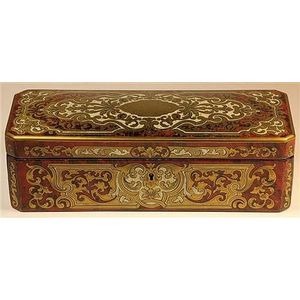Maori-themed Writing Compendium by William Seuffert
William Seuffert, rare writing compendium, composed of specimen native timbers with traditional European parquetry and New Zealand marquetry flora, fauna and indigenous Maori themes, made by William Seuffert in 1905. Height 42 cm. Width 36.5 cm. Depth 23 cm. Further description: Depicting Auckland with Rangitoto and the Waitemata harbour and with an inlaid kiwi, also with the initials 'FSB', dated 1905 and 'N.Z.' inlaid. Featuring manuka flowers and basket-weave parquetry in rewarewa with spiral and scrolling Maori motifs including the spiral waka prows (tauihu) that frame the scene. The interior with a gilded leather writing surface. The marquetry timbers include rimu, puriri, rewarewa, burr totara and tawa
You must be a subscriber, and be logged in to view price and dealer details.
Subscribe Now to view actual auction price for this item
When you subscribe, you have the option of setting the currency in which to display prices to $Au, $US, $NZ or Stg.
This item has been sold, and the description, image and price are for reference purposes only.
- Gilding - Gilding is a method of ornamentation whereby a thin sheet of gold metal is applied to items made of wood, leather, ceramics, glass and silver for decorative purposes.
For furniture including mirrors, the sheet of gold is usually applied over a coating of gesso. Gesso is a mixture of plaster of Paris and gypsum mixed with water and then applied to the carved wooden frames of mirrors and picture frames as a base for applying the gold leaf. After numerous coats of gesso have been applied, allowed to dry and then sanded a coat of "bole", a usually red coloured mixture of clay and glue is brushed on and allowed to dry, after which the gold leaf is applied. Over time parts of the gilding will rub off so the base colour can be seen. In water gilding, this was generally a blue colour, while in oil gilding, the under layer was often yellow. In Victorian times, gilders frequently used red as a pigment beneath the gold leaf.
Metal was often gilded by a process known as fire gilding. Gold mixed with mercury was applied and heated, causing the mercury to evaporate, the long-term effect of which was to kill or disable the craftsman or woman from mercury poisoning. The pursuit of beauty has claimed many victims, not the least of which were the artists who made those pieces so highly sought after today. - Burr - Burr (or in the USA, burl) is the timber from the knotted roots or deformed branch of the tree, which when cut, displays the small circular knots in various gradations of colour. It is always cut into a decorative veneer, most commonly seen as burr walnut on 19th century furniture.
- Compendium - A compendium is usually a wooden box that has several compartments and drawers for storing the various items. A stationery compendium would be used for storing and organizing various personal or business items including documents, business cards, passports, and other items that need to be organized and easily accessible. It is typically a wooden box t
A compendium for correspondence would usually have pockets for holding different sizes of envelopes, and sometimes may have a built-in address book or a calendar. It can also have a pen loop or holder, and sometimes a calculator.A compendium for games would usually have pockets for holding game pieces, cards and sometimes rule books. It can also have a space for a chess or checkers board.A sewing compendium would have compartments for thimbles, bobbins, needles etc.
This item has been included into following indexes:
Visually similar items

Tibetan cabinet with hand painted & lacquered finish, early 20th century. Height 109 cm, width 85 cm, depth 37 cm
Sold by
in
for
You can display prices in $Au, $US, $NZ or Stg.

Boulle writing box veneered with cut brass and scarlet tortoise shell and filled mother of pearl. Designed with a fall front mechanism, with key. Dimensions 26.5 x 10 x 8 cm
Sold by
in
for
You can display prices in $Au, $US, $NZ or Stg.

A modern embossed metal mounted jewellery box, 33 cm wide
Sold by
in
for
You can display prices in $Au, $US, $NZ or Stg.

A Moroccan blanket box with mother of pearl inlay
Sold by
in
for
You can display prices in $Au, $US, $NZ or Stg.
